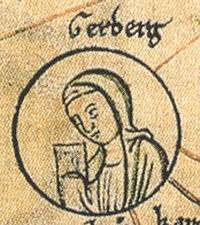Gerberga of Saxony
| Gerberga of Saxony | |
|---|---|
|
Image of Gerberga taken from a miniature depicting the genealogy of the Ottonian dynasty in the Chronica St. Pantaleonis, 2nd half of 12th century (Herzog August Bibliothek, Wolfenbüttel, Cod. Guelf. 74.3 Aug., pag. 226) | |
| Queen consort of France | |
| Tenure | 939–954 |
| Born | 913 |
| Died | 984 |
| Spouse |
Gilbert, Duke of Lorraine Louis IV of France |
| Issue more... |
Lothair of France Matilda, Queen of Burgundy Charles, Duke of Lower Lorraine |
| House | Ottonian |
| Father | Henry the Fowler |
| Mother | Matilda of Ringelheim (Saint) |
Gerberga of Saxony (also Gerberga of France) (c. 913 – 5 May 968/9 or 984?) was a member of the Ottonian dynasty and a descendant of Charlemagne. Her first husband was Gilbert, Duke of Lorraine. Her second husband was Louis IV of France. Contemporary sources describe her as a highly educated, intelligent and forceful political player.
Life
Family
Gerberga was born c.913. She was the oldest daughter of Henry the Fowler, King of Germany, and his second wife, Matilda. Her older brother was Otto I of Germany.
First marriage
In 928, Gerberga married her first husband, Gilbert, Duke of Lorraine.[1] They had four children:
- Alberade of Lorraine b. about 929. Married Renaud (originally as Ragenold), a Viking chieftain who became the Count of Roucy
- Henry, Duke of Lorraine b. about 932
- Gerberge of Lorraine b. about 935. Married Adalbert I of Vermandois.
- Wiltrude, b. about 937.
Jocundus, a Lotharingia chronicler writing in the 1070s, recorded that Gerberga was the driving force behind Gilbert's decision to support her younger brother Henry when he rebelled against her older brother Otto I c.936.[2] Giselbert was defeated by Otto I in 939 at the Battle of Andernach and, while trying to escape, drowned in the Rhine.
Second marriage
When Gilbert died, Gerberga was about 26 years old. She married secondly Louis IV of France in 939. They were parents to eight children:
- Lothair of France (941–986)
- Matilda b. about 943; married Conrad of Burgundy
- Hildegarde b. about 944
- Carloman b. about 945
- Louis b. about 948
- Charles, Duke of Lower Lorraine (953–993)
- Alberade b. before 953
- Henry b. about 953
Widowhood
As regent
Louis IV died on 10 September 954. At this time, his son and heir with Gerberga, Lothair of France, was only thirteen. Gerberga took action to ensure that Lothar could succeed his father. She reached an agreement with her brother-in-law Hugh the Great, who had been an adversary to Lothair's father.[3] In exchange for supporting Lothair's rule Hugh was given rule over Aquitaine and much of Burgundy[4] Gerberga did not seek the support of her brother, Emperor Otto I, because the interference of the East-Frankish emperor in West-Frankish affairs would have placed the West-Frankish kingdom in a weak position politically, and angered the West-Frankish nobles.
After the death of Hugh the Great in 956, Gerberga and her sister Hadwig (who was Hugh's widow) were the heads of the two most powerful dynasties in West Francia. Along with their brother, Bruno, who was both archbishop of Cologne and duke of Lotharingia, Gerberga and Hadwig ruled the kingdom, until Lothair came of age.[5]
As abbess
In 959, after Lothair had come of age, Gerberga became abbess of the Benedictine monastery of Notre Dame in Soissons. Nevertheless, she remained politically active. In 961 she was involved in choosing the new archbishop of Reims, Odalric. In 965 she was present at the imperial court in Cologne, when her son Lothair married Emma of Italy, the step-daughter of her brother Emperor Otto I.
Death
There is some debate about when Gerberga died.[6] She is last documented in May 968. Since necrology records indicate that she died on 5 May, her date of death is often given as 968 or 969,[7] but others maintain that Gerberga did not die until 984.[8] She is buried in the Abbey of Saint-Remi in Reims, Champagne.
Sources
- Bouchard, Constance Brittain, Those of My Blood: Constructing Noble Families in Medieval Francia (University of Pennsylvania Press, 2001).
- "Women in power 750-1000" from Guide2womenleaders.com, last accessed January 13, 2007
- Jocundus, Translatio sancti Servatii Tungrensis episcopi et miracula, ed. R. Koepke, MGH SS 12 (Hannover, 1856), accessible online at: Monumenta Germaniae Historica
- W. Glocker, Die Verwandten der Ottonen und ihre Bedeutung in der Politik. Studien zur Familienpolitik und zur Genealogie des sächsischen Kaiserhauses (1989).
- D. Schwennicke, Europäische Stammtafeln Neue Folge Band I. 1
- A. Thiele, Erzählende genealogische Stammtafeln zur europäischen Geschichte Band I, Teilband 1
External links
- Medieval Lands Project
- Eduard Hlawitschka (1964), "Gerberga", Neue Deutsche Biographie (NDB) (in German) 6, Berlin: Duncker & Humblot, pp. 256–257; (full text online) (in German)
- Gerberga von Sachsen (in German)
References
- ↑ On Gerberga's marriage to Gilbert, and their children, see Glocker, Verwandten, pp. 28–33.
- ↑ Jocundus, Translatio, pp. 123f., but Glocker, Verwandten, p. 32 argues against this view.
- ↑ The Annals of Flodoard of Reims, 916–966, eds & trans. Steven Fanning: Bernard S. Bachrach (New York; Ontario, Can: University of Toronto Press, 2011), p. xix
- ↑ Bourchard, Constance Brittain (1999). "Burgundy and Provence:879-1032". In Reuter, Timothy; McKitterick, Rosamond; Abulafia, David. The New Cambridge Medieval History: Vol. III, c.900 - c.1024 (Link is extract=Volume III, Chapter 1 "Introduction: Reading the Tenth Century") (PDF) III (1. publ. ed.). Cambridge: Cambridge University Press. p. 336. ISBN 0521364477. Retrieved 28 February 2013.
- ↑ Glocker, Verwandten, esp. pp. 37–45.
- ↑ For an overview, see Glocker, Verwandten, p. 272.
- ↑ Hlawitschka, 'Gerberga,' p. 256; Schwennicke, Europäische Stammtafeln, table 10
- ↑ e.g. Thiele, Erzählende genealogische Stammtafeln, table 11.
| Preceded by Emma of France |
Queen of Western Francia 939–954 |
Succeeded by Emma of Italy |
|
